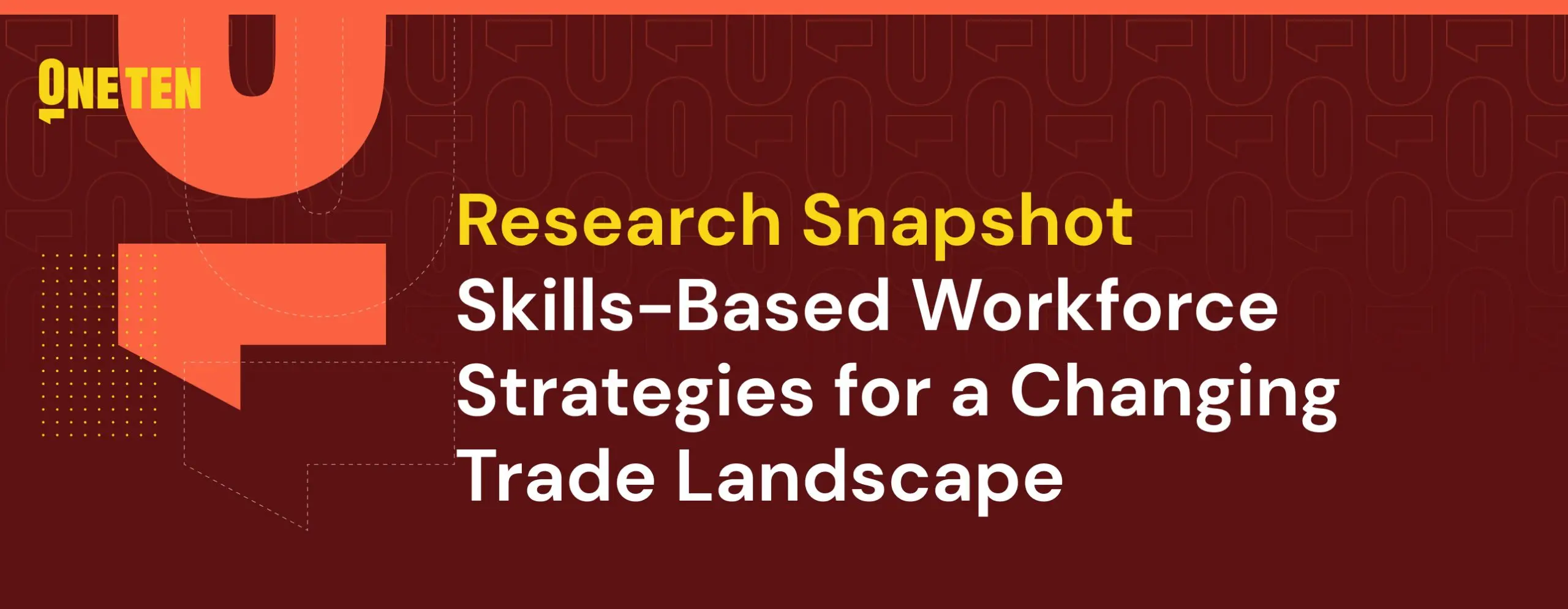Skills-Based Workforce Strategies for a Changing Trade Landscape

10.31.2025
How Can Skills-Based Hiring Strategies Help Companies Navigate a Changing Trade Landscape?
Skills-based hiring strategies can transform how companies prepare for shifting market dynamics. Concerns about tight labor markets, supply chain shifts and workforce transitions are prompting companies across the U.S. to take a closer look at how they prepare for what's next. By adopting skills-based workforce strategies, employers can build resilience, maintain productivity and future-proof their operations against continued trade and economic uncertainty.
While some of these changes are still taking shape, the uncertainty alone is creating pressure to adapt quickly and wisely. One of the most effective, underutilized levers is how companies hire, promote, and advance talent. Skills-based and skills-first hiring—an approach that prioritizes demonstrated capabilities over four-year degree requirements—offers a practical, flexible way to strengthen your workforce and build long-term resilience. Considering that there are an estimated 151M working-age adults without four-year degrees, removing degree barriers and adopting skills-first hiring practices can unlock a massive, often overlooked talent pool. This pool becomes even more valuable during economic shifts and when competition for qualified candidates intensifies, offering companies a way to fill critical roles and maintain productivity in uncertain conditions.
While it's too early to draw firm conclusions, recent labor market data continue to show signs of declining momentum, with the August 2025 jobs report showing only 22,000 jobs added, down from 79,000 in July. This follows a downward revision of 27,000 for June and an upward revision of 6,000 for July. The unemployment rate ticked up slightly to 4.3 percent, and labor force participation held steady at 62.3 percent. Industries often sensitive to trade and supply chain dynamics, like manufacturing and construction, continued to lose jobs in August (19,000), marking a four-month slide. These indicators point to emerging signs of strain due to trade and immigration policies.
Even in a cooling labor market, workforce needs don't disappear—they evolve. Shifts in trade policy and supply chain demands are influencing where companies operate, how they allocate resources, and which skills they need most.
Below, we demonstrate how a skills-based workforce strategy can help your organization stay ahead by addressing workforce needs in a dynamic trade environment. By aligning your talent strategy with current conditions, you can turn change into opportunity.
Scaling up U.S. Operations
Business Implication: As companies reshore operations, they must rethink traditional talent sourcing and prioritize job-relevant skills to build an agile, resilient workforce that can respond faster to evolving business needs.
Skills-Based Solution:
- Broaden domestic hiring pools and accelerate hiring timelines to meet evolving workforce needs. Findings from the OneTen Hiring Managers' Study, Embracing a Skills-First Mindset, show that hiring managers using skills-first practices are able to fill roles more efficiently and reduce time-to-hire.
- Reduce reliance on offshore capacity, especially where visa constraints create complexity while enabling faster alignment with new domestic production needs. Studies show that skills-first talent can deliver comparable productivity relative to their degree-holding peers and demonstrate increased loyalty and engagement.
- Expand access to domestic talent through partnerships with apprenticeship programs, vocational schools, and credential providers. For example, tap into local earn-and-learn programs and community colleges that train non-degreed workers to pursue careers in the skilled trades.
Adapting to Global Workforce Patterns
Business Implication: Shifting immigration dynamics are affecting talent availability in key sectors like manufacturing, construction and logistics forcing companies to rethink workforce development.
Skills-Based Solution:
- Remove degree requirements for middle-skills roles, which can support rapid certification for machine operators
- Tap into the 8% of veterans with construction experience
- Unlock transferable skills among the 75% of rural workers without degrees
Supporting Regional Supply Networks
Business Implication: Evolving trade conditions are driving a shift to local supply chains and production methods, changing how companies source and allocate talent.
Skills-Based Solution:
- Partner with community colleges and training providers that certify talent in sectors likely to be impacted (e.g., manufacturing, transportation, energy, wholesale trade), to build local pipelines without relocation costs or delays.
Building Operational Agility
Business Implication: Dynamic trade conditions require quick operational pivots to redeploy talent based on shifting skill needs.
Skills-Based Solution:
- Redeploy existing talent efficiently through strategic workforce forecasting anchored by skills taxonomies. For example, if semiconductor imports are restricted, skills taxonomies can identify technician roles that could transition to domestic chip manufacturing with targeted
- Leverage Al-driven skills taxonomies, dashboards and real-time skills intelligence tools to support internal mobility and upskilling, a strategy reinforced by findings from the OneTen Research Snapshot, Building a Skills Taxonomy Leveraging AI.
By adopting skills-based workforce strategies, companies can strengthen operational flexibility, reduce hiring bottlenecks and respond swiftly to evolving trade conditions.
For a deeper look at how skills-first strategies drive value in a dynamic economic environment, click here to access OneTen's full report, "Staying Ahead of the Curve: Harnessing the Power of Skills-First Practices During Economic Uncertainty."
Download the PDF